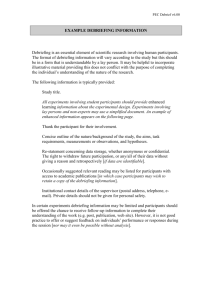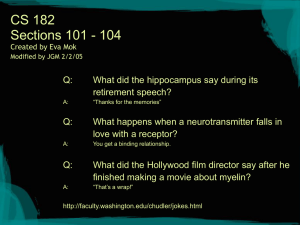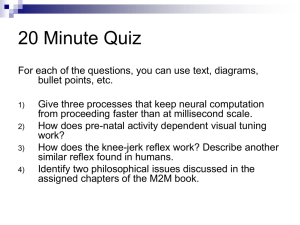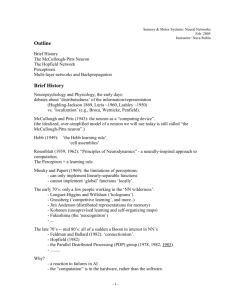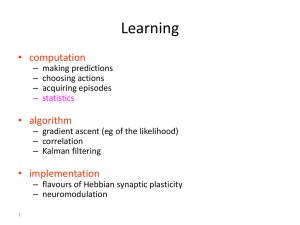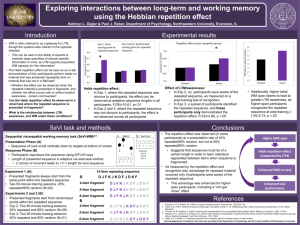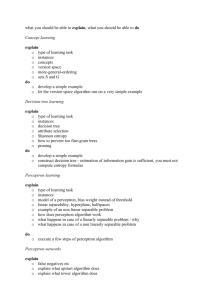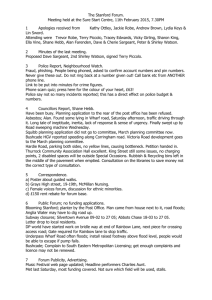Hebb
advertisement
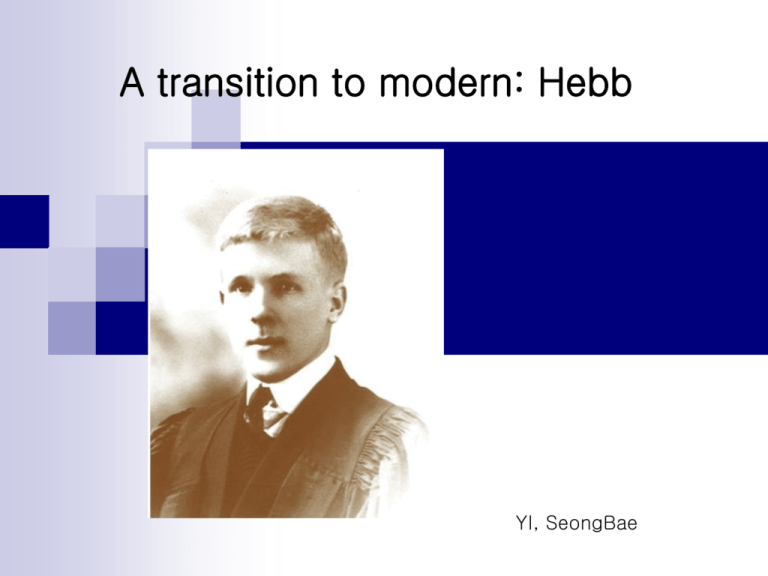
A transition to modern: Hebb YI, SeongBae Questions What is the main idea of Hebb’s theory if we say in a easy way? Why it is important to repeat to learn something? What is the difference between Hebb and other behaviorists? Contents Hebb’s Neurophysiological Assumptions Hebb’s rule Habituation and Sensitization Hebb’s contribution Hebb’s experiment He found that His pet is smarter than others in lab. In repeated experiment, a rat with more abundant stimulus(in more active environment), it has more enlarged synapse The enlarged area of a brain consumes more energy than others It means that more active areas of the brain form more synase associations and links Hebb’s Neurophysiological Assumptions (Hebb’s rule) Repeated transmission of impulses between two cells leads to permanent facilitation of transmission between these cells. Espescially, repeated strong stimulus often makes neurons enlarged, and the amout of released transmitters increases significantly P. aurelia, a unicellular animal, can be also trained. Todd Hennessey gave them electric shocks + siren repeatedly, and they ran away only with the siren. A bacterium also can be trained. Bacteria and neurons are a kinds of protien Hebb’s Neurophysiological Assumptions (cell asembly) Neural cells may be reactivated repeatedly because of their own activity The circuit of firing is called a cell asembly Neuron synapse Cell assembly Hebb’s Neurophysiological Assumptions (phase sequence) If a number of related cell assemblies are simultaneously active, they will become linked in phase sequence We can think that each cell assembly corresponds to a simple sensory input, while a phase sequence corresponds to more complex action, for example, a recognition Small circuits are cell assemblies which form more complex circuit, phase sequences Hebb’s rule If input from neuron A contributes often enough to firing of neuron B, then the synapse form A to B will change and become stronger A B A B A B The connections become stronger and more active In large scale, the repetition of the same sensory event leads to the same pattern of neural firing and, eventually, to the formation of associated assemblies of cells. Hebb’s rule (cont.) In other words, repetition of simulation, that is learning, leads to repeated activation of the same sets of neurons and to the eventual formation of cell assemblies and phase sequences It explains - why we must repeat when study, why it is important to have a good habit when young, or why it is so hard to change a habit Learning reoganize brain, brain reoganize character Habituation and Sensitization In experiments on aplysia, it quickly habituates to repeated light touches and stops responding. Habituation is clear evidence that something has been learned IF Habituation But repeated stimulation does not always lead to habituation. If we use electric shocks, the aplysia’s siphon may cause instant and very decided retraction IF zzz Sensitization Neurologically, sensitization leads to long-term potentiation(LTP)-a lasting increase in the responsiveness of neurons In contrast, habituation leads to long-term depression (LTD)-a lasting decline in the responsiveness of relevant neurons. Hebb’s contribution He focused on higher mental processes rather than traditional S-R theories He brought a consideration of phsiological mechanisms back into the study of learning and behavior The idea, that learning change the physical structure of the brain, acts as the basic assumption of neuroscience Some of his thought are used as the basis of a neural network model (Chapter 8) Questions and Answers What is the main idea of Hebb’s theory if we say in a easy way? Why it is important to repeat to learn something? Learning can reoganize the brain (enlarged synpase, faster firing, neuron associations) Repeated stimulus and response make related phase sequences function more efficiently What is the difference between Hebb and other behaviorists? He focused on higher mental processes rather than traditional S-R theories He did not analyze behavior at a molecular level(reductionist) but did at a molar perspective, he assumed that behavior could be understood as a whole Thank you
